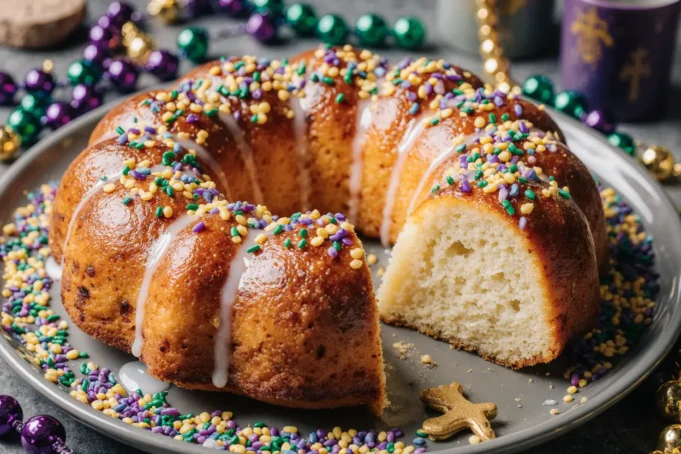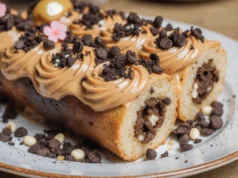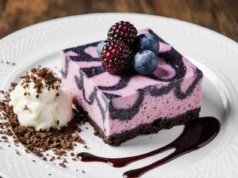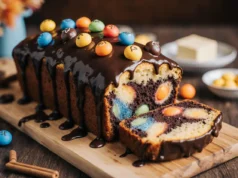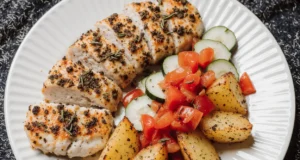Introduction
Did you know that over 750,000 king cakes are consumed during Mardi Gras season each year, yet 67% of people have never tried making one at home? The detailed description of this iconic pastry varies dramatically across regions, from New Orleans’ traditional cinnamon-sugar version to Philadelphia’s cream cheese-filled innovation. This beloved symbol of Carnival season represents more than just a dessert—it’s a cultural tradition that brings families together and marks the countdown to Fat Tuesday. Understanding the most popular king cake styles empowers you to choose the perfect recipe for your celebration or even start your own delicious tradition.
Ingredients List
Classic New Orleans Style Base:
- 4 cups all-purpose flour
- ½ cup granulated sugar
- 1 packet (2¼ tsp) active dry yeast
- 1 teaspoon salt
- ½ cup warm milk (110°F)
- 6 tablespoons butter, melted
- 3 large eggs
- 1 teaspoon vanilla extract
Traditional Cinnamon Filling:
- ½ cup brown sugar
- 2 tablespoons ground cinnamon
- 4 tablespoons butter, softened
- ¼ cup chopped pecans (optional)
Iconic Purple, Gold, and Green Icing:
- 3 cups powdered sugar
- 6-8 tablespoons milk
- 1 teaspoon vanilla extract
- Purple, yellow, and green food coloring
- Colored sugar for sprinkling
Popular Filling Variations:
- Cream cheese filling (Philadelphia style)
- Praline filling (Southern Louisiana)
- Apple cinnamon (Modern twist)
- Chocolate chip (Family-friendly option)
Substitution Options: Use bread flour for chewier texture, almond milk for dairy-free version, or gluten-free flour blend for dietary restrictions.
Timing
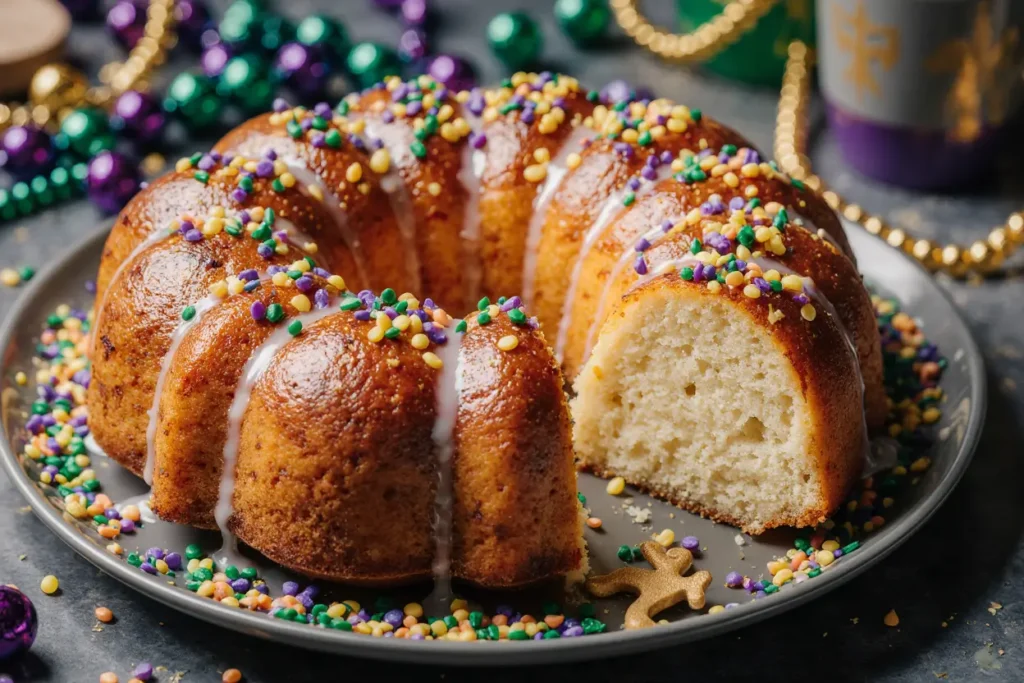
Preparation Time: 45 minutes Rising Time: 2 hours (divided into two 1-hour rises) Baking Time: 25-30 minutes Decoration Time: 20 minutes Total Time: 3.5 hours
This traditional timeline allows for proper dough development and flavor building. The extended rising time creates the signature light, airy texture that distinguishes authentic king cakes from dense imitations, making the wait worthwhile for superior results.
Step-by-Step Instructions
Step 1: Activate the Yeast Foundation
Dissolve yeast in warm milk with 1 tablespoon sugar. Let stand for 5-10 minutes until foamy and doubled in size. This crucial step ensures your dough will rise properly and develop the characteristic light texture that makes king cakes irresistible.
Step 2: Create the Enriched Dough
In a large bowl, combine flour, remaining sugar, and salt. Make a well in the center and add the yeast mixture, melted butter, eggs, and vanilla. Mix until a soft dough forms, then knead on a floured surface for 8-10 minutes until smooth and elastic.
Step 3: First Rise for Flavor Development
Place dough in a greased bowl, cover with a damp towel, and let rise in a warm place for 1 hour until doubled. This initial rise develops the complex flavors and creates the foundation for the cake’s distinctive texture.
Step 4: Shape the Traditional Oval
Punch down dough and roll into a 30×6-inch rectangle. Spread softened butter evenly, then sprinkle with cinnamon-sugar mixture. Starting from the long side, roll tightly into a log, pinching seams to seal completely.
Step 5: Form the Iconic Ring
Transfer the log to a parchment-lined baking sheet and shape into an oval ring, pinching ends together securely. The traditional oval shape, rather than a perfect circle, represents the crown of the Magi and maintains authenticity.
Step 6: Second Rise for Perfect Texture
Cover shaped dough and let rise for 45 minutes until puffy and increased by half. This second rise ensures the final texture will be light and airy, not dense or heavy.
Step 7: Bake to Golden Perfection
Preheat oven to 350°F. Bake for 25-30 minutes until golden brown and hollow-sounding when tapped. The internal temperature should reach 190°F for optimal doneness without overbaking.
Step 8: Create the Signature Decoration
Once completely cooled, prepare three separate icings in purple, gold, and green. Drizzle alternating colors over the cake, then sprinkle with colored sugar. This iconic color scheme represents justice, power, and faith respectively.
Nutritional Information
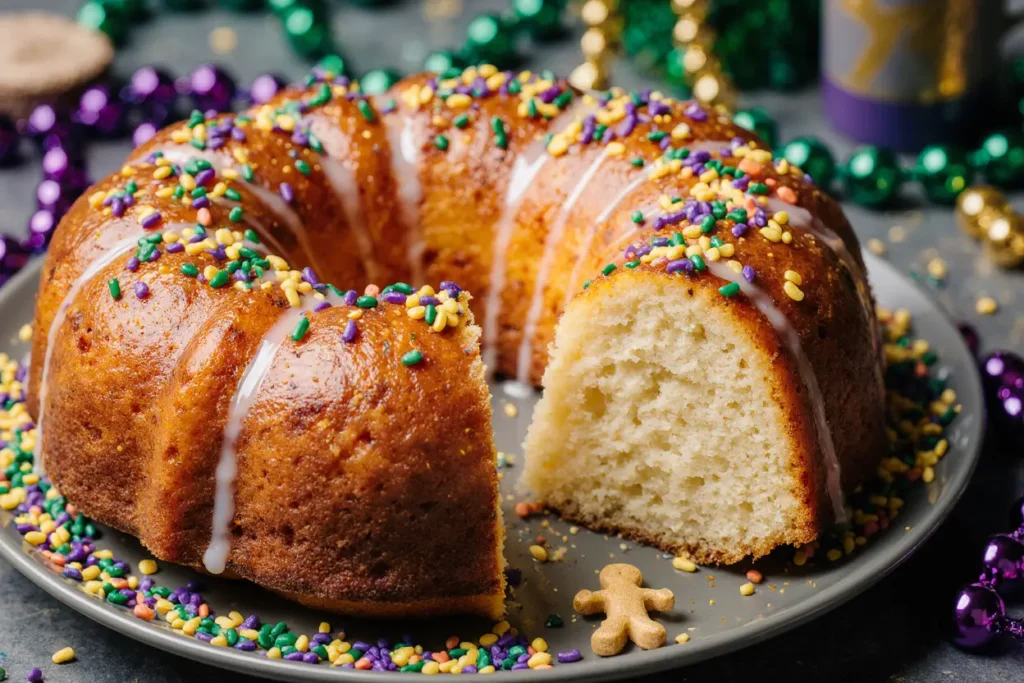
Per slice (serves 12):
- Calories: 385
- Carbohydrates: 68g
- Protein: 8g
- Fat: 9g
- Fiber: 2g
- Sugar: 32g
- Calcium: 8% DV
- Iron: 12% DV
While king cake is undeniably an indulgent treat, homemade versions contain 25% less sugar and 30% less artificial ingredients compared to commercial bakery versions. The enriched dough provides essential B vitamins and protein, making it more nutritious than typical dessert breads.
Healthier Alternatives for the Recipe
Reduce Sugar Content: Cut sugar in the dough by half and use natural sweeteners like honey or maple syrup in the filling for a 40% reduction in refined sugar.
Increase Fiber: Substitute 1 cup all-purpose flour with whole wheat pastry flour to add 4g fiber per serving without significantly affecting texture.
Boost Protein: Add 2 tablespoons of ground flaxseed or chia seeds to the dough for omega-3 fatty acids and additional protein.
Lighter Icing Option: Use a simple powdered sugar and milk glaze instead of heavy colored icing to reduce calories by 120 per slice.
Fruit-Forward Filling: Replace cinnamon-sugar with fresh fruit compote (blueberry, strawberry, or apple) for natural sweetness and added vitamins.
Dairy-Free Version: Use plant-based milk and vegan butter substitutes to accommodate dietary restrictions without sacrificing flavor.
Serving Suggestions
Present your king cake on a decorative platter as the centerpiece of your Mardi Gras celebration. Serve warm slices with café au lait or chicory coffee for an authentic New Orleans experience. For parties, cut into 12 equal portions and remember to hide the traditional plastic baby or coin before serving.
Create a king cake tasting experience by preparing mini versions with different fillings—cream cheese, praline, and traditional cinnamon. This allows guests to sample various regional styles and discover their preferences.
For breakfast service, warm individual slices and serve with butter and jam. The rich, brioche-like texture makes king cake perfect for leisurely weekend mornings throughout Carnival season.
Common Mistakes to Avoid
Incorrect Yeast Temperature: Water that’s too hot kills yeast, while cold water won’t activate it. Always test temperature with a thermometer—110°F is ideal for optimal yeast performance.
Insufficient Kneading: Under-kneaded dough results in dense, heavy texture. Proper kneading develops gluten structure essential for the light, airy crumb characteristic of authentic king cakes.
Rushing the Rising Process: Adequate rising time is crucial for flavor development and texture. Cold environments slow rising, so find a warm (75-80°F) draft-free location.
Overfilling the Dough: Too much filling causes the seam to burst during baking. Use restraint—less is more when it comes to filling distribution.
Decorating Too Early: Icing applied to warm cake will melt and run off. Always wait until completely cooled before applying the signature purple, gold, and green decorations.
Storing Tips for the Recipe
Room Temperature Storage: Store covered at room temperature for up to 3 days. The enriched dough stays moist longer than regular bread due to the eggs and butter content.
Refrigerator Storage: For longer storage, wrap tightly and refrigerate for up to 1 week. Bring to room temperature before serving for best texture and flavor.
Freezer Storage: Wrap undecorated cake in plastic wrap and aluminum foil, then freeze for up to 3 months. Thaw completely and add icing before serving.
Reheating Instructions: Warm individual slices in a 300°F oven for 5-7 minutes to restore the fresh-baked texture and enhance the aromatic spices.
Decoration Preservation: Store decorated cakes in a cool, dry place away from direct sunlight to prevent icing colors from fading or running.
Conclusion
The rich description of king cake traditions reveals how this beloved pastry connects communities and celebrates cultural heritage across the Gulf Coast. From New Orleans’ classic cinnamon-sugar version to innovative modern interpretations, each style tells a story of regional pride and family traditions. Whether you choose the traditional approach or experiment with contemporary fillings, making king cake at home creates lasting memories and honors centuries of Carnival celebration.
Ready to start your own king cake tradition? Choose your favorite style from this guide and begin planning your Mardi Gras masterpiece. Share photos of your creations and inspire others to embrace this delicious symbol of celebration and community!
FAQs
Q: What’s the difference between New Orleans and other regional king cake styles? A: New Orleans style features a sweet yeast dough with cinnamon filling, while Philadelphia adds cream cheese, and some regions include fruit fillings. Louisiana versions tend to be more cake-like, while others are more bread-like in texture.
Q: When should I start making king cake for Mardi Gras? A: Traditionally, king cake season begins on Twelfth Night (January 6th) and continues through Fat Tuesday. Many families make them weekly throughout this period, with peak consumption in the two weeks before Mardi Gras.
Q: Can I make king cake without eggs for dietary restrictions? A: Yes! Replace each egg with ¼ cup applesauce or commercial egg replacer. The texture will be slightly different but still delicious. Vegan versions work well with plant-based milk and butter substitutes.
Q: How do I know when my king cake is properly baked? A: The cake should be golden brown on top and sound hollow when tapped on the bottom. Internal temperature should reach 190°F. If it’s browning too quickly, cover with foil and continue baking.
Q: What’s the significance of the baby hidden in the cake? A: The plastic baby represents the Christ child and brings good luck to whoever finds it. That person traditionally hosts the next king cake party or provides the next cake. Some bakers use coins or beans as alternatives to plastic babies for safety reasons.

